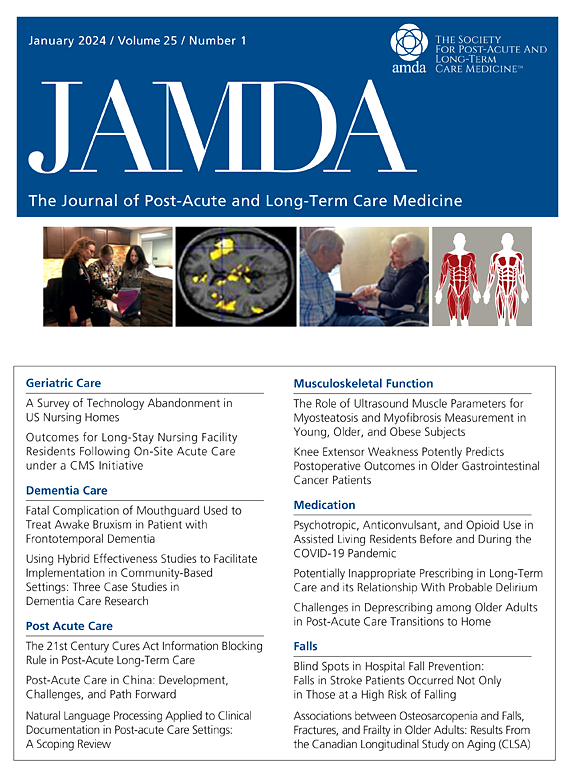Fall Risk–Increasing Drugs and Fall-Related Injuries among Older Adults in Ontario: A Population-Based Matched Case-Control Study
IF 4.2
2区 医学
Q2 GERIATRICS & GERONTOLOGY
Journal of the American Medical Directors Association
Pub Date : 2025-04-09
DOI:10.1016/j.jamda.2025.105567
引用次数: 0
Abstract
Objectives
Commonly prescribed medications individually increase the risk of falls. Less is known about the association between multiple fall risk–increasing drug (FRID) use and falls. We examined the association between 12 major FRID classes, alone and in combination and fall-related injuries among older adults in home care (HC) and long-term care (LTC) settings.
Design
Matched, case-control study.
Setting and Participants
HC recipients and LTC residents in Ontario, Canada, from 2008 to 2016.
Methods
Cases were matched to controls by sex, age, history of falls, calendar year, and disease risk score. Using multivariable logistic regression, the associations between FRID exposure in the 90 days preceding falls and fall-related injuries that required emergency department or hospitalization were determined with adjusted odds ratios (aORs) and 95% confidence intervals (CIs).
Results
Exposure to any FRID increased the risk of fall-related injury when compared with non-users in both HC (aOR, 1.34; 95% CI, 1.30–1.40) and LTC (aOR, 1.54; 95% CI, 1.46–1.63) populations. The increased odds of fall-related injuries were evident among most FRID categories, with the highest odds found with dopaminergic agents and antidepressants in both HC and LTC populations. The use of multiple FRIDs was associated with a greater odds of fall-related injury. Exposure to ≥5 FRIDs was associated with an almost twofold higher odds of fall-related injury in HC (aOR, 1.67; 95% CI, 1.57–1.77) and LTC (aOR, 1.92; 95% CI, 1.73–2.13) residents compared with non-users. The findings were similar across multiple subgroups and sensitivity analyses, with higher odds among new users compared with chronic users.
Conclusions and Implications
Multiple categories of FRIDs are associated with an increased risk of fall-related injuries in older adults. Clinicians should minimize use of these medications wherever possible. Fall prevention initiatives should incorporate strategies to prioritize deprescription of the highest risk FRIDs.
求助全文
约1分钟内获得全文
求助全文
来源期刊
CiteScore
11.10
自引率
6.60%
发文量
472
审稿时长
44 days
期刊介绍:
JAMDA, the official journal of AMDA - The Society for Post-Acute and Long-Term Care Medicine, is a leading peer-reviewed publication that offers practical information and research geared towards healthcare professionals in the post-acute and long-term care fields. It is also a valuable resource for policy-makers, organizational leaders, educators, and advocates.
The journal provides essential information for various healthcare professionals such as medical directors, attending physicians, nurses, consultant pharmacists, geriatric psychiatrists, nurse practitioners, physician assistants, physical and occupational therapists, social workers, and others involved in providing, overseeing, and promoting quality

 求助内容:
求助内容: 应助结果提醒方式:
应助结果提醒方式:


